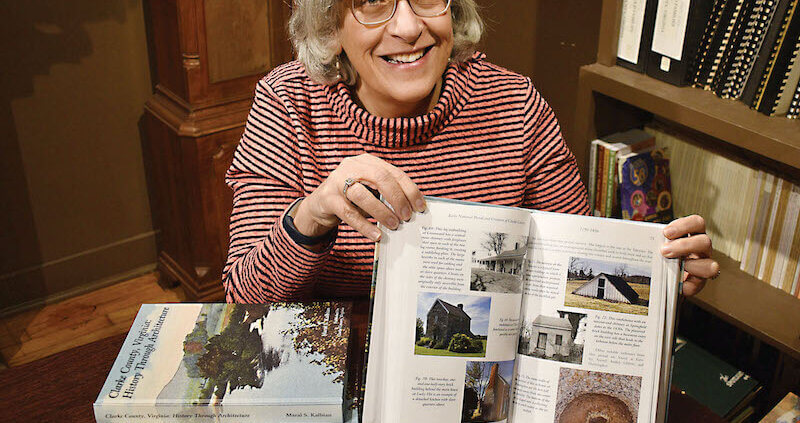New Book Explores Clarke County History Through Architecture
By Cathy Kuehner
Towns and counties across America developed as settlers arrived, built homes that often reflected the architecture of their heritage, and established businesses to serve their new and growing communities. Clarke County’s history is the story of its settlers and slaves, property owners and entrepreneurs, and its agricultural- and agrarian-based economy.
A new book by architectural historian Maral S. Kalbian, “Clarke County, Virginia: History Through Architecture,” introduces the reader to the first people known to live in the area, guides readers through the development of roads and communities, and explains the architectural styles of its grand estates and humble houses.
“I thoroughly enjoyed working on this book, although it was overwhelming at times,” said Kalbian, a professional architectural historian and preservation consultant. “I wanted to include as much as possible, and write it in a way that keeps the reader engaged. Not every historic property is included, but I wrote about as many as I could to tell the story of
Clarke County.”
Kalbian, a longtime Clarke resident, was also determined to separate fact from fiction, tracking down widely held beliefs and finding documented evidence to either support or debunk them. “There are discrepancies in past historical writings, so I double- and tripled-checked some stories in order to give future researchers a better place to start.”
Kalbian’s meticulous research and the publication of “Clarke County, Virginia: History Through Architecture” was funded through a Certified Local Government (CLG) grant from the Virginia Department of Historic Resources as well as funds from the Clarke County Conservation Easement Authority (approved by the Board of Supervisors), the Clarke County Historical Association, and the Clarke-based Clermont Foundation. Grants and contributed funds totaled $33,000.
Clarke County’s Historic Preservation Commission oversaw the project that began in early 2021. The Commission oversaw earlier CLG grants that funded other studies of Clarke history, including an African-American historic context (2002), a countywide archaeological assessment (1994), an archaeological mill study (1996), and a driving tour (2015). Additionally, almost 40 Cultural Resource Management reports have been written about resources in the county. Kalbian researched and wrote most of them.
“Because so much has been written about Clarke’s history, I used architecture as the thread that ties the story together,” Kalbian said of her new book. Indeed, by offering details about the styles, building materials, and construction of homes, businesses, barns, churches, and schools, Kalbian paints a vivid picture of how people lived from the 1700s through the early 20th century.
Of course, until early 1836, there was no Clarke County; it was eastern Frederick County. The state Senate officially established Clarke County on March 8, 1836, by separating it from Frederick County along Opequon Creek. The incorporated town of Berryville was selected Clarke’s seat
of government.
The end of the Civil War in 1865 and the completion of the Shenandoah Valley Railroad in 1879 led to a boom in residential and business construction in Clarke, including many Black communities built
by freed slaves.
Thus, chapters in Kalbian’s new book are organized chronologically with historic resources detailed in each chapter by type or theme. By using architecture as the thread, the reader can see how the landscape dictated the placement of roads, towns, and farms, and how architectural elements of each structure served specific functions for their occupants.
“Previously published technical reports are not always easily accessible to citizens or government officials,” Kalbian said. “My primary goal with this book is to assemble historical information in a way that is more accessible and appreciated by all ages of the general public. The book may even provide the framework for school curricula or other public history venues focusing on Clarke’s broad history and culture.”
Historic Preservation Commission chair Betsy Arnett said, “The production of this thoroughly professional account of Clarke County’s historic built environment is a major accomplishment. Commission members were delighted to support Maral’s work through the CLG grant program, including all the past studies and resource reports that informed her work on this new book.”
Arnett continued, “I think many people don’t realize what an asset Maral is to our community. To have an architectural historian and historic preservationist of her caliber working for our benefit is really quite amazing. This book is a labor of love for Maral, and it shows.”
“Clarke County, Virginia: History Through Architecture” is a hardcover, full-color, and richly illustrated book. It is available for $75 at the Clarke County Historical Association located at 32 E. Main St. in Berryville. Checks should be made payable to Maral Kalbian. Only 200 copies were printed, although additional copies may be printed. To purchase a book or for more information, contact Kalbian at (540) 955-1231 or maral@mkalbian.com.










